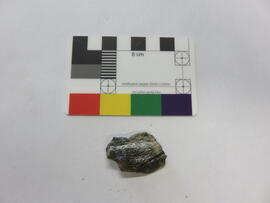A number of stratified contexts at the site contained fragments of glass. The majority of this material, however, consisted of window glass, or else was derived from 19th century vessels of minimal interest. Nevertheless, four contexts were identified that did contain significant material. These comprise 015, 043, 096, and 097.
In addition, a relatively large glass assemblage was recovered from unstratified deposits in Trenches 1 and 2. Although the majority of the material was very modern in date, the finds also included <127>
F.18, <035>: contained a base fragment derived from a cylindrical bottle, or possibly a goblet. It weighs 4g, and is post-Medieval in date. Two fragments of window glass were also present in this context.
<073> 7g, Context 34, North of Hall
<098> 78g, Context 45
696g
(partially discarded)
<102> stem only
Trench 2 MNI 39:
Bowls (MNI 20)
2 type 4 c.1600-40
1 type 5 c.1640-60
6 type 6 c.1660-80
4 type 9 c.1680-1710
3 type 10 c.1700-40
3 type 12 c.1730-80
1 type 23 bowl c.1760-1800 with initials RW on sides of spur. No obvious local source.
Heels/spurs (MNI 19)
3 heels with initials IK on side. Produced by James Kuquit of Cambridge, active c.1713-50.
1 heel with initials IK on side and stamped crown mark in relief on base. Produced by James Kuquit of Cambridge, active c.1713-50.
1 heel with initials on side and stamped eight spoked wheel mark on base
1 heel with stamped five petalled Tudor rose mark on base (see above)
1 heel with incuse letter C on base. This is paralleled by two finds from the St. John’s Triangle site (Cessford in Newman 2008). These were dated to c.1730-80 and the mark could potentially relate to John Carter, active in Cambridge c.1703-26.
1 heel with initials WP on sides and unclear I stamped symbol on base, bowl form c.1700+. Possibly William Phipos of Cambridge, who died in 1740.
1 heel with initials PW on sides, bowl form c.1700+. No obvious local source, the initials PW have been found in the Cambridge area before dated c.1760-80 and a London origin was suggested (Flood 1976, 46)
10 plain heels/spurs plus large bowl fragments
Decorated stem
1 stem with impressed curvilinear decoration
A single worked stone fragment was recovered from a stratified context. This consisted of a fine-grained bluish grey vesicular quernstone fragment that is identifiable as Niedermendig Műlstein lava (also known as Rhenish or Mayen lava) from the Eifel region in Germany (Kars 1983). Although such querns were frequently used during the Roman period, and are common finds on Middle and Late Saxon sites, they are much rarer in the Medieval period as their use was controlled following the Norman Conquest and many people were instead compelled to use centrally regulated mills (Watts 2002, 38-42). Therefore, although it occurred residually in a later context, this example is likely to be pre-12th century in origin.
[016], F.19, <058>: a Niedermendig Műlstein lava quern fragment. It measures 105mm by 96mm in extent and 30mm thick, and weighs 414g.
Chapel Doorway: a plain chamfered vault rib.
Chapel Doorway: the corner of a sloping windowsill?
Chapel Doorway: a plain chamfered doorjamb, with rebate for door.
<042>: Context 15
<065>: Context 33, TP outside wine cellar
Includes finds lists, brief for archaeological evaluation, specification for archaeological evaluation, reports, evaluation trench record sheets, context record sheets, site and trench plans and drawings, photographic record sheet, slides and photographs.






































